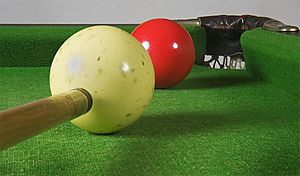Collision facts for kids
A collision occurs when two objects come in contact with each other. All collisions have the same momentum before and after a collision. Examples of collisions include car crashes, bouncing a ball, and playing pool. Collisions are made from two smaller sections called elastic and inelastic collisions.

Elastic Collisions
In the case of playing pool or bouncing a ball, an elastic collision occurs. An elastic collision generally occurs when an elastic or hard object experiences a collision that bounces off another elastic or hard object, where the kinetic energy and momentum are the same before and after the collision. In an experiment, a small amount of energy will still be lost because of the friction between the surface and the objects.
Inelastic Collisions
In the case of a car crash, an inelastic collision occurs. An inelastic collision generally occurs when a soft object experiences a collision that does not result in a bounce. Kinetic energy is lost during this type of collision because the energy is transformed into other forces. The momentum is the same before and after the collision.
Two Dimensional Collisions
In the case of a two dimensional collision, the rules in elastic and inelastic collision are still the same, but vectors are used to find the momentum before or after a collision.
Images for kids


